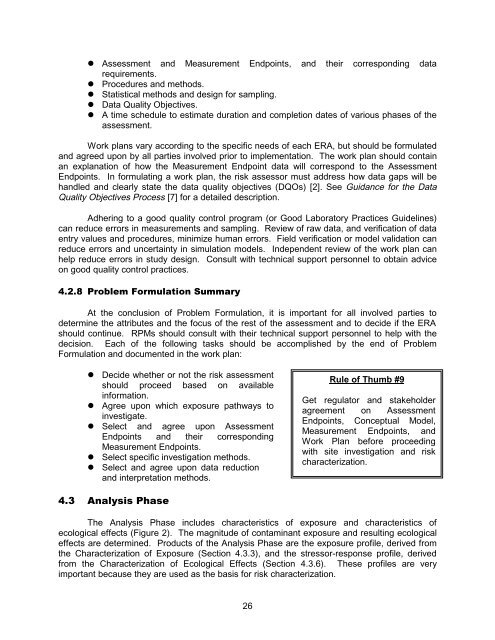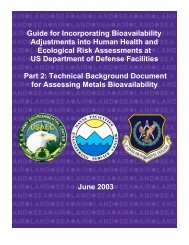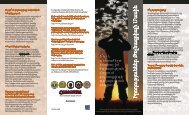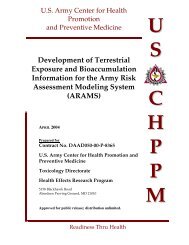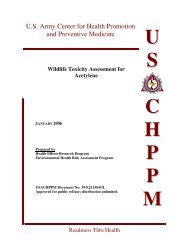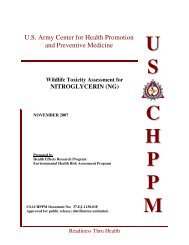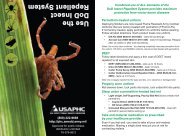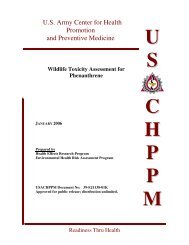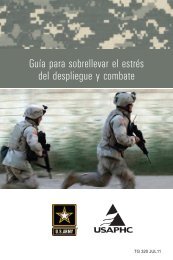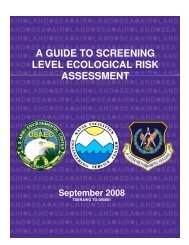Tri-Service Remedial Project Manager's Guide for Ecological Risk ...
Tri-Service Remedial Project Manager's Guide for Ecological Risk ...
Tri-Service Remedial Project Manager's Guide for Ecological Risk ...
You also want an ePaper? Increase the reach of your titles
YUMPU automatically turns print PDFs into web optimized ePapers that Google loves.
l Assessment and Measurement Endpoints, and their corresponding datarequirements.l Procedures and methods.l Statistical methods and design <strong>for</strong> sampling.l Data Quality Objectives.l A time schedule to estimate duration and completion dates of various phases of theassessment.Work plans vary according to the specific needs of each ERA, but should be <strong>for</strong>mulatedand agreed upon by all parties involved prior to implementation. The work plan should containan explanation of how the Measurement Endpoint data will correspond to the AssessmentEndpoints. In <strong>for</strong>mulating a work plan, the risk assessor must address how data gaps will behandled and clearly state the data quality objectives (DQOs) [2]. See Guidance <strong>for</strong> the DataQuality Objectives Process [7] <strong>for</strong> a detailed description.Adhering to a good quality control program (or Good Laboratory Practices <strong>Guide</strong>lines)can reduce errors in measurements and sampling. Review of raw data, and verification of dataentry values and procedures, minimize human errors. Field verification or model validation canreduce errors and uncertainty in simulation models. Independent review of the work plan canhelp reduce errors in study design. Consult with technical support personnel to obtain adviceon good quality control practices. 3UREOHP)RUPXODWLRQ6XPPDU\At the conclusion of Problem Formulation, it is important <strong>for</strong> all involved parties todetermine the attributes and the focus of the rest of the assessment and to decide if the ERAshould continue. RPMs should consult with their technical support personnel to help with thedecision. Each of the following tasks should be accomplished by the end of ProblemFormulation and documented in the work plan:l Decide whether or not the risk assessmentshould proceed based on availablein<strong>for</strong>mation.l Agree upon which exposure pathways toinvestigate.l Select and agree upon AssessmentEndpoints and their correspondingMeasurement Endpoints.l Select specific investigation methods.l Select and agree upon data reductionand interpretation methods.Rule of Thumb #9Get regulator and stakeholderagreement on AssessmentEndpoints, Conceptual Model,Measurement Endpoints, andWork Plan be<strong>for</strong>e proceedingwith site investigation and riskcharacterization.$QDO\VLV3KDVHThe Analysis Phase includes characteristics of exposure and characteristics ofecological effects (Figure 2). The magnitude of contaminant exposure and resulting ecologicaleffects are determined. Products of the Analysis Phase are the exposure profile, derived fromthe Characterization of Exposure (Section 4.3.3), and the stressor-response profile, derivedfrom the Characterization of <strong>Ecological</strong> Effects (Section 4.3.6). These profiles are veryimportant because they are used as the basis <strong>for</strong> risk characterization.26


